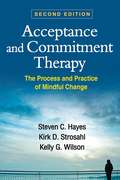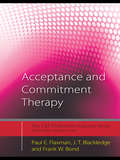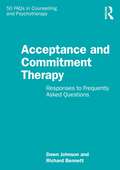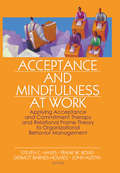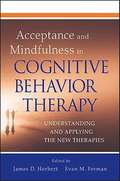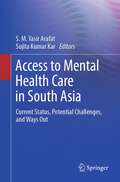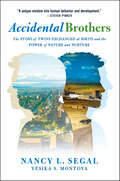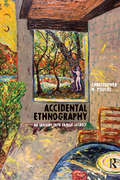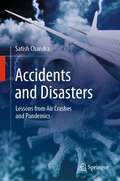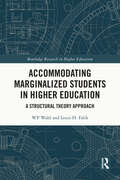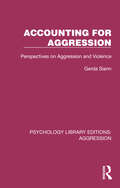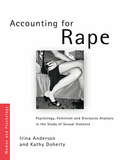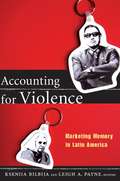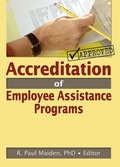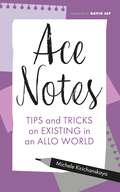- Table View
- List View
Acceptance and Commitment Therapy, Second Edition
by Steven C. Hayes Kirk D. StrosahlSince the original publication of this seminal work, acceptance and commitment therapy (ACT) has come into its own as a widely practiced approach to helping people change. This book provides the definitive statement of ACT--from conceptual and empirical foundations to clinical techniques written by its originators. ACT is based on the idea that psychological rigidity is a root cause of a wide range of clinical problems. The authors describe effective, innovative ways to cultivate psychological flexibility by detecting and targeting six key processes: defusion, acceptance, attention to the present moment, self-awareness, values, and committed action. Sample therapeutic exercises and patient-therapist dialogues are integrated throughout. New to This Edition, Reflects tremendous advances in ACT clinical applications, theory building, and research. Psychological flexibility is now the central organizing focus. Expanded coverage of mindfulness, the therapeutic relationship, relational learning, and case formulation. Restructured to be more clinician friendly and accessible; focuses on the moment-by-moment process of therapy.
Acceptance and Commitment Therapy: 100 Key Points and Techniques (100 Key Points)
by Richard Bennett Joe OliverAcceptance and Commitment Therapy: 100 Key Points and Techniques offers a comprehensive, yet concise, overview of the central features of the philosophy, theory, and practical application of ACT. It explains and demonstrates the range of acceptance, mindfulness, and behaviour change strategies that can be used in the service of helping people increase their psychological flexibility and wellbeing. Divided into three main parts, the book covers the ‘Head, Hands, and Heart’ of the approach, moving from the basics of behavioural psychology, via the key principles of Relational Frame Theory and the Psychological Flexibility model, to a detailed description of how ACT is practiced, providing the reader with a solid grounding from which to develop their delivery of ACT-consistent interventions. It concludes by addressing key decisions to make in practice and how best to attend to the therapeutic process. The authors of Acceptance and Commitment Therapy bring a wealth of experience of using ACT in their own therapy practice and of training and supervising others in developing knowledge and skills in the approach. This book will appeal to practitioners looking to further their theoretical knowledge and hands-on skills and those seeking a useful reference for all aspects of their ACT practice.
Acceptance and Commitment Therapy: 100 Key Points and Techniques (100 Key Points)
by Richard Bennett Joseph E. OliverThis book offers a comprehensive overview of the central theoretical tenets of Acceptance and Commitment Therapy (ACT), guidance on key practical applications of the approach, and reflection on the strategic issues inherent to the delivery of this psychological intervention.This thoroughly revised edition explains and demonstrates the range of acceptance, mindfulness, and behaviour change strategies that can be used in the service of helping people increase their psychological flexibility and wellbeing. Divided into three main parts, the book provides the reader with a solid grounding from which to develop their delivery of ACT-consistent interventions. This new edition also includes an update of the research literature and a review of new developments, techniques, and approaches within ACT theory and practice, fortified with a greater appreciation of diversity issues, such as the application of ACT across different groups and cultures.This book will be of interest to students and practitioners of ACT from a range of disciplines spanning clinical, organisational, coaching, counselling, and psychotherapy settings.
Acceptance and Commitment Therapy: Distinctive Features (CBT Distinctive Features)
by Frank W. Bond Paul E. Flaxman J.T. BlackledgeWhat are the distinctive theoretical and practical features of acceptance and commitment therapy? Acceptance and commitment therapy (ACT) is a modern behaviour therapy that uses acceptance and mindfulness interventions alongside commitment and behaviour change strategies to enhance psychological flexibility. Psychological flexibility refers to the ability to contact the present moment and change or persist in behaviour that serves one’s personally chosen values. Divided into two sections, The Distinctive Theoretical Features of ACT and The Distinctive Practical Features of ACT, this book summarises the key features of ACT in 30 concise points and explains how this approach differs from traditional cognitive behaviour therapy. Acceptance and Commitment Therapy provides an excellent guide to ACT. Its straightforward format will appeal to those who are new to the field and provide a handy reference tool for more experienced clinicians.
Acceptance and Commitment Therapy: Responses to Frequently Asked Questions (50 FAQs in Counselling and Psychotherapy)
by Richard Bennett Dawn JohnsonAcceptance and Commitment Therapy (ACT) is an evidence-based contemporary psychological approach to behaviour change that promotes the idea of people living more in line with their values whilst providing them with practical strategies for managing adversity. In this book, Dawn Johnson and Richard Bennett have collated fifty of the questions that have most frequently been put to them whilst delivering ACT training and supervision to a wide range of therapists and other helping professionals. This book is the first of its kind to provide concise answers to a range of philosophical, theoretical, conceptual, and practical questions raised by practitioners who are learning ACT. It will be of interest to psychotherapists, clinical psychologists, counsellors, psychiatrists, and a broad range of other mental health practitioners and trainees. It serves as a useful resource for those new to the practice of ACT, and for more experienced practitioners who might want to consider these questions themselves.
Acceptance and Mindfulness at Work: Applying Acceptance and Commitment Therapy and Relational Frame Theory to Organizational Behavior Management
by Dermot Barnes-Holmes Steven C. Hayes John Austin Frank W. BondAn innovative and effective approach to organizational behavioral management Despite more than 40 years of empirical and conceptual research, the contribution of behavior analysis to the world of business remains relatively small and organizational behavior management gets little attention in both the academic and professional communities. Acceptance and Mindfulness at Work presents behavioral analysis of human language that&’s ready to use, with applied extensions proven to have a significant impact in organizational settings. The leading experts in the field examine how these ongoing developments can help broaden the exploration of the psychological issues relevant to organizational behavioral management (OBM) in the workplace.Acceptance and Mindfulness at Work presents conceptual and empirical articles, and reviews of working examples of Relational Frame Theory (RFT) and Acceptance and Commitment Therapy (ACT) applied to organizational behavior management. The book examines goal setting, feedback, task descriptions, and workers&’ ability to learn as examples of how to affect positive change in organizations through increased productivity and improved quality of life in the workplace. The possibilities presented by RTF can lead to advancements in employee safety and training, stress and health management, employee evaluation, managing absenteeism, tardiness, and turnover, and self-management.Acceptance and Mindfulness at Work examines: cognition in OBM industrial/organization (I/O) psychology how interventions using ACT have increased psychological flexibility rule-following feedback task performance feedback programmed schedules of reinforcement goal setting, goal statements, and goal-directed behavior how psychological flexibility and job control can predict learning, job performance, and mental health and much moreAcceptance and Mindfulness at Work is a vital professional resource for organization development practitioners and human resource managers.
Acceptance and Mindfulness in Cognitive Behavior Therapy
by James D. Herbert Evan M. FormanPraise for Acceptance and Mindfulness in Cognitive Behavior Therapy: Understanding and Applying the New Therapies"One of the most fruitful aspects of the encounter between classical Buddhist knowledge and modern science has been the emergence of new therapeutic and educational approaches that integrate contemplative practice, such as mindfulness, and contemporary psychology methods, such as those of cognitive therapy. The systematic approach of this book, wherein the insights of both classical Buddhist and contemporary psychology are integrated, represents a most beneficial and powerful method of ensuring a healthy mind and heart."--His Holiness the Dalai Lama"What has been missing in the midst of partisan battles between orthodox CBT therapists and enthusiastic proponents of newer acceptance/mindfulness approaches is a reasoned, scientifically grounded discourse that would help researchers and clinicians alike sort through the various claims and counterclaims. This book, skillfully conceived and edited by James Herbert and Evan Forman, provides just such a sober and open-minded appraisal of a trend that has sometimes suffered both from too much hype from one side and too sweeping a rejection by the other. This volume encourages careful consideration of both positions and can advance evidence-based psychosocial therapy both conceptually and procedurally to the benefit of all."--From the Foreword by Gerald C. Davison, PhD, University of Southern CaliforniaAcceptance and Mindfulness in Cognitive Behavior Therapy: Understanding and Applying the New Therapies brings together a renowned group of leading figures in CBT who address key issues and topics, including:Mindfulness-based cognitive therapyMetacognitive therapyMindfulness-based stress reductionDialectical behavior therapyUnderstanding acceptance and commitment therapy in context
Access and Inclusion for Children with Autistic Spectrum Disorders: 'Let Me In'
by Christine Breakey Matthew HesmondhalghBased on pioneering work at their school in Sheffield, the authors of this book explore the universal issues of access and inclusion in employment and education for children and young people with autism or Asperger's Syndrome. They describe the challenges they faced in establishing and running an Integrated Resource for these children within a mainstream secondary school. The twenty-four pupils at The Resource participate in the regular school curriculum, but also learn a wide range of additional life skills. These include road safety, work-place skills and using public transport as well as expressing feelings, making choices and learning from experience. One innovative area of work at The Resource is the work placement scheme which has given pupils the opportunity to work with local companies including a supermarket and an insurance firm. In addition to this, The Resource has established a partnership with a further education college to enable their pupils to gain further support after they leave school. These projects demonstrate the encouraging possibilities in employment and the wider world for young people on the autistic spectrum. The experiences of these special pupils and their peers and teachers provide lessons as well as messages of hope and understanding for parents and professionals within the field of autism. The authors make useful, practical suggestions for access and inclusion, showing how those with autism or Asperger's Syndrome can participate fully in the world of work and the community.
Access to Mental Health Care in South Asia: Current Status, Potential Challenges, and Ways Out
by S. M. Yasir Arafat Sujita Kumar KarThis book is about access to mental health care in South Asia. South Asia consists of eight countries with low and middle-income backgrounds. The region contains a combined population of about 2 billion, making up about a quarter of the global population. The people of this region share common cultures, beliefs, and behavioral patterns regarding physical and mental health. Among them, about 15% (about 300 million) have been suffering from common mental disorders. However, there is a persisting high treatment gap for mental illness in the region. Hence, despite having a mental illness, only a small percentage of the population is able to have access to essential mental healthcare. Though governments are trying to bridge the gap by improving mental health policies and programs, it is still a major challenge delivering mental healthcare to all people in need. Due to the income category and dual disease burden of the countries, there are some additional enduring challenges like poor funding and research, inadequate and inequitable manpower, huge out-of-pocket expenses, poor mental health literacy, income disparity, and high stigma. This book aims to highlight the issues related to accessing mental health services in a densely populated low and middle-income setting. This book is the first of its kind in comparing and contrasting the delivery status of mental health services in South Asian countries.
Accessibility in Text and Discourse Processing: A Special Issue of Discourse Processes
by Morton Ann Gernsbacher Ted J.M. SandersThis special issue shows how accessibility phenomena need to be studied from a linguistic and psycholinguistic angle, and in the latter case from interpretation, as well as production. The contributions augment the growing knowledge of accessibility in text and discourse processing. They also illuminate how accessibility is marked in a text or a discourse, how readers and listeners respond to those markings, and how mental representations evolve and change as a direct result of accessibility. The editors hope is that the text affects the readers' representations in ways that linguists and psycholinguists theorize as beneficial.
Accessing the Clinical Genius of Winnicott: A Careful Rendering of Winnicott’s Twelve Most Influential Clinical papers
by Teri QuatmanDonald Winnicott, psychoanalyst and pediatrician, is viewed by many in the psychodynamic field as the “other genius” in the history of psychodynamic theory and practice, along with Freud. This book selects and explores twelve of his most infl uential clinical papers. Winnicott’s works have been highly valued in the decades since they were first published, and are still relevant today. Winnicott’s writings on the goals and techniques of psychodynamic psychotherapy have been foundational, in that he recast Freudian- and Kleinian-infl uenced thinking in the direction of the more relational schools of psychotherapy that define current 21st-century psychodynamic practice. Winnicott’s writings help us to understand the maturational processes of children, certainly. But more than that, they help us to understand how best to intervene when the enterprise of childhood leads to compromises of psychological health in later years. Yet, despite Winnicott’s influence and continuing relevance, his writings, while at some level simple, are elusive to modern readers. For one thing, he writes in the psychoanalytic genre of the 1930s-1960s, whose underlying theoretical assumptions and vocabulary are obscure in the present day and, for another, his writing often reflects primary process thinking, which is suggestive, but not declarative. In this work, Teri Quatman provides explanations and insight, in an interlocution with Winnicott’s most significant papers, exploring both his language and concepts, and enabling the clinician to emerge with a deep and reflective understanding of his thoughts, perspectives, and techniques. Engaging and accessible, Accessing the Clinical Genius of Winnicott will be of great use to anyone encountering Winnicott for the first time, particularly in psychodynamic psychotherapeutic training, and in the teaching of relational psychotherapies.
Accessing the Healing Power of the Vagus Nerve: Self-Help Exercises for Anxiety, Depression, Trauma, and Autism
by Benjamin Shield Stephen W. Porges Stanley RosenberyThis practical guide to understanding the cranial nerves as the key to our psychological and physical well-being builds on Stephen Porges’s Polyvagal Theory—one of the most important recent developments in human neurobiology. Drawing on more than thirty years of experience as a craniosacral therapist and Rolfer, Stanley Rosenberg explores the crucial role that the vagus nerve plays in determining our psychological and emotional states and explains that a myriad of common psychological and physical symptoms—from anxiety and depression to migraines and back pain—indicates a lack of proper functioning in the vagus nerve. Through a series of easy self-help exercises, the book illustrates the simple ways we can regulate the vagus nerve in order to initiate deep relaxation, improve sleep, and recover from injury and trauma. Additionally, by exploring the link between a well-regulated vagus nerve and social functioning, Rosenberg’s findings and methods offer new hope that by improving social behavior it is possible to alleviate some of the symptoms at the core of many cases of autism spectrum disorders. Useful for psychotherapists, doctors, bodyworkers, and caregivers, as well as anyone who experiences the symptoms of chronic stress and depression, this book shows how we can optimize autonomic functioning in ourselves and others, and bring the body into the state of safety that activates its innate capacity to heal.
Accidental Brothers: The Story of Twins Exchanged at Birth and the Power of Nature and Nurture
by Nancy L. Segal Yesika S. Montoya"A unique window into human behavior and development." —Steven PinkerThe riveting story of two sets of identical twins separated at birth and improbably reunited as adults, a dream case for exploring nature and nurture.Accidental Brothers tells the unique story of two sets of identical Colombian twin brothers who discovered at age 25 that they were mistakenly raised as fraternal twins—when they were not even biological brothers. Due to an oversight that presumably occurred in the hospital nursery, one twin in each pair was switched with a twin in the other pair. The result was two sets of unrelated “fraternal” twins—Jorge and Carlos, who were raised in the lively city of Bogotá; and William and Wilber, who were raised in the remote rural village of La Paz, 150 miles away. Their parents and siblings were aware of the enormous physical and behavioral differences between the members of each set, but never doubted that the two belonged in their biological families. Everyone’s life unraveled when one of the twins—William—was mistaken by a young woman for his real identical twin, Jorge. Her “discovery” led to the truth—that the alleged twins were not twins at all, but rather unrelated individuals who ended up with the wrong families. Blending great science and human interest, Accidental Brothers by Nancy L. Segal and Yesika S. Montoya will inform and entertain anyone interested in how twin studies illuminate the origins of human behavior, as well as mother-infant identification and the chance events that can have profound consequences on our lives.
Accidental Ethnography: An Inquiry into Family Secrecy (Writing Lives Ser. #7)
by Christopher N. PoulosEach family has its secrets, ones that shape family communication and relationships in a way generally unknown to the outsider and often the family itself. Autoethnographers, students of these relationships, confront many silences in their attempts to understand these social worlds. Now issued as a Routledge Education Classic Edition, Accidental Ethnography delves into this shadowy world of pain and loss in the hopes of finding productive, ethical avenues for transforming the secret lives of families into powerful narratives of hope. It merges autoethnographic method with the therapeutic power of storytelling to heal family wounds. A new preface text by the author reflects on the changes in the field of qualitative research and on his own research journey since the publication of the original edition.
Accidental Ethnography: An Inquiry into Family Secrecy (Writing Lives: Ethnographic Narratives #7)
by Christopher N PoulosEach family has its secrets, ones that shape family communication and relationships in a way generally unknown to the outsider and often the family itself. Autoethnographers, students of these relationships, confront many silences in their attempts to understand these social worlds. It is often the accidental slip, the spontaneous discussion, the offhanded comment that opens this terrain of secrets to the conscientious storyteller. Accidental Ethnography delves into this shadowy world of pain and loss in the hopes of finding productive, ethical avenues for transforming the secret lives of families into powerful narratives of hope. It merges autoethnographic method with the therapeutic power of storytelling to heal family wounds. Poulos’s lyrical text will appeal to those in ethnography, interpersonal communication, and family relationships alike.
Accidental Genius: Using Writing to Generate Your Best Ideas, Insights, and Content
by Mark LevyLevy shows readers how to tap into their most powerful creative thinking by using a variety of writing exercises. This second edition includes updates on how to use these exercises to generate raw material for books, articles, presentations, blog posts, and tweets.
Accidents and Disasters: Lessons from Air Crashes and Pandemics
by Satish ChandraThis book deals with the contemporary subject of perception of risk and its influence on accidents and disasters. The contents examine the conventional viewpoints on human errors, incubation of errors, complexity and organisational deviance as a cause for accidents. Work of Mary Douglas with regard to risk, Charles Perrow's work on the normal accident theory and Diane Vaughn's theory on normalisation of deviance are examined from a fresh perspective in this book. It also discusses prominent accidents in aviation, space, nuclear energy, automotive and healthcare, using the pandemic and Boeing 737 Max as a backdrop to study accidents and disasters. It further explores the background and similarities to these events and addresses the core issues such as the state of regulation, the worldview of the sociologists, and proposes that mental models of complex systems, avarice and risk for gain as other possibilities for accidents. Using the concept of nudge in behavioural economics and the Elinor Ostrom’s viewpoint on regulating for common good, it suggests a way forward through the High Reliability Organisation Theory (HRO) leading to enhanced risk perception. The book will be of interest to those who would like to understand the need to incorporate risk perception into regulation, engineers and scientists, professionals and policy makers working in the areas of disaster and risk management, technology areas like aviation, nuclear plants, space and healthcare, students of the sociology of risk and of course the general reader.
Accommodating Marginalized Students in Higher Education: A Structural Theory Approach (Routledge Research in Higher Education)
by Louis H. Falik WP WahlThis book defines and examines the needs of the marginalized student and presents a theoretically grounded model to guide institutions of higher education toward developing new and more effective programmatic responses. Taking the implementational experience of the University of the Free State (UFS) in Bloemfontein, South Africa, as a case study, it investigates the experience of students who present problems of learning and inadequate preparation for sustained performance, including learning disabilities, lack of study skills, motivational factors, and cultural support systems. Further, it identifies the pressure for institutions to be responsive to social and political pressures to accommodate the needs of students previously excluded from participation in higher educational or vocational training opportunities. In addressing this timely area of development, the authors formulate a unique conceptual foundation for the consideration of a new paradigm, based on cognitive and biosocial theories: those of the theory of structural cognitive modifiability and mediated learning experience and of Feuerstein and Bronfenbrenner’s ecosystem structural orientation. Innovative, applicational, and optimistic in nature, this book will appeal to scholars, researchers, administrators, and postgraduate level students working across the fields of higher education, educational psychology, and student counseling.
Accomplishing Permanency: Reunification Pathways And Outcomes For Foster Children (SpringerBriefs in Well-Being and Quality of Life Research #7)
by Elizabeth FernandezReunification is a primary goal of foster care systems and the most common permanency planning decision. It is defined as the return of children placed in protective care to the home of their birth family and used to describe the act of restoring a child in out-of-home care back to the biological family. Yet reunification decision-making and the process of reintegrating children into birth families remains under researched. This Brief takes a look at family reunification knowledge and research in Australia where there is evidence that most children placed in protective care are eventually reunited with their birth parents. It explores how a knowledge of reunification decision making and outcomes can contribute to strengthening practice and informing policy formulation and program planning in Child Welfare.
Accounting for Aggression: Perspectives on Aggression and Violence (Psychology Library Editions: Aggression)
by Gerda SiannThe despair and incomprehension that often seem to be the only possible response to acts of aggression and violence have led to attempts by academics and writers from a wide variety of backgrounds to understand and explain such behaviour. The concern and anxiety that is felt by many people about this subject is such that some of their accounts – notably by Konrad Lorenz, Desmond Morris, Robert Ardrey, and Anthony Storr – have become popular and even best-selling books.Originally published in 1985, Accounting for Aggression provides a comprehensive synthesis and assessment of these writings and other contemporary theory and research on aggression and violence at the time. The author presents a variety of accounts of aggression, drawing on original work in the areas of biology, sociobiology, ethology, psychology and sociology. Each account is evaluated according both to the criteria of scientific methodology and to the extent to which it illuminates our understanding and appears to have a lasting explanatory value. In the last chapter the author presents an integrative approach to the subject area which synthesizes those findings for which there appears to be substantial empirical support, within a framework of the meaning that aggressive and violent behaviour offers to those who carry it out.Accounting for Aggression will be of great value to students and practitioners in the fields of psychology, psychiatry, social work and education. Furthermore, it will be welcomed by interested members of the general public who are concerned with issues such as whether or not violence is inherent in human nature, the extent to which interpersonal violence is related to group violence, and the extent to which violence in the media affects violent behaviour.
Accounting for Rape: Psychology, Feminism and Discourse Analysis in the Study of Sexual Violence (Women and Psychology)
by Irina Anderson Kathy DohertyAccounting for Rape presents an original perspective on the subject of rape, focusing on both female and male sexual violence. The authors investigate everyday beliefs about rape, to examine how blaming the victim and the normalization of rape are achieved by people in a discussion about sexual violence. They synthesize discursive psychology and a feminist standpoint to explore precisely how rape and rape victimhood are defined in ways that reflect the social, political and cultural conditions of society. By analysing conversational data, Anderson and Doherty suggest that the existing social psychological experimental research into rape and rape perception fails to analyse the subtlety and political significance of rape supportive reasoning. Accounting for Rape provides a critical interrogation of the dominant theories and methodologies, focusing on: How the gender and sexual orientation of alleged victims and perpetrators is crucial to social participants when making sense of a rape report and in apportioning blame and sympathy How arguments that are critical of alleged victims are built in ways that are 'face saving' for the participants in the conversations, and how victim-blaming arguments are presented as 'common sense'. The potential of applying this approach in both professional and academic contexts to promote attitude change. The book will be of great interest to those studying social and clinical psychology, cultural studies, sociology, women's studies and communication studies.
Accounting for Violence: Marketing Memory in Latin America
by Leigh A. Payne Ksenija BilbijaAccounting for Violence offers bold new perspectives on the politics of memory in Latin America. Scholars from across the humanities and social sciences provide in-depth analyses of the political economy of memory in Argentina, Brazil, Chile, Mexico, Peru, and Uruguay, countries that emerged from authoritarian rule in the 1980s and 1990s. The contributors take up issues of authenticity and commodification, as well as the "never again" imperative implicit in memory goods and memorial sites. They describe how bookstores, cinemas, theaters, the music industry, and television shows (and their commercial sponsors) trade in testimonial and fictional accounts of the authoritarian past; how tourist itineraries have come to include trauma sites and memorial museums; and how memory studies has emerged as a distinct academic field profiting from its own journals, conferences, book series, and courses. The memory market, described in terms of goods, sites, producers, marketers, consumers, and patrons, presents a paradoxical situation. On the one hand, commodifying memory potentially cheapens it. On the other hand, too little public exposure may limit awareness of past human-rights atrocities; such awareness may help to prevent their recurring. Contributors. Rebecca J. Atencio, Ksenija Bilbija, Jo-Marie Burt, Laurie Beth Clark, Cath Collins, Susana Draper, Nancy Gates-Madsen, Susana Kaiser, Cynthia E. Milton, Alice A. Nelson, Carmen Oquendo Villar, Leigh A. Payne, José Ramón Ruisánchez Serra, Maria Eugenia Ulfe
Accreditation of Employee Assistance Programs
by R Paul MaidenExplore the evolution, development, and applications of accreditation standards for employee assistance programs! Accreditation ensures private or public sector organizations that an employee assistance program (EAP) has an acceptable level of experience, advisement, and expertise. Accreditation of Employee Assistance Programs examines all facets of EAP accreditation while revealing the council on accreditation (COA) standards. Thorough and focused chapters discuss the value of EAP accreditation to future customers, the development of accreditation standards for employee assistance programs, and the smoothest road to travel to your destination of EAP accreditation.Accreditation of Employee Assistance Programs describes in depth the evolution, development, and applications of accreditation standards for EAPs. Respected authorities discuss the history and outlook of accreditation while providing valuable information on the entire process. Illustrative case studies provide further valuable insight. Accreditation of Employee Assistance Programs explores: the history of accreditation of EAPs in the United States and Canada EAP core technology the best strategies for developing standards for accreditation the COAs employee accreditation process in-depth accreditation case studies the future of credentialing and accreditation in EAPsThorough and informative, Accreditation of Employee Assistance Programs is of interest to those in employee assistance professions, benefits consultants, human resource managers, and students in the EAP field.
Acculturation: A Personal Journey across Cultures (Elements in Psychology and Culture)
by John W. BerryAcculturation is the process of group and individual changes in culture and behaviour that result from intercultural contact. These changes have been taking place forever, and continue at an increasing pace as more and more peoples of different cultures move, meet and interact. Variations in the meanings of the concept, and some systematic conceptualisations of it are presented. This is followed by a survey of empirical work with indigenous, immigrant and ethnocultural peoples around the globe that employed both ethnographic (qualitative) and psychological (quantitative) methods. This wide-ranging research has been undertaken in a quest for possible general principles (or universals) of acculturation. This Element concludes with a short evaluation of the field of acculturation; its past, present and future.
Ace Notes: Tips and Tricks on Existing in an Allo World
by Michele KirichanskayaWhat is the ace lens?Is my relationship queerplatonic?Am I sex-favorable, sex-averse or sex-repulsed?As an ace or questioning person in an oh-so-allo world, you're probably in desperate need of a cheat sheet. Allow us to introduce your new asexual best friend, an essential resource serving up the life hacks you need to fully embrace the ace. Expect interviews with remarkable aces across the spectrum, advice on navigating different communities , and low-key ways to flaunt your ace identity.Covering everything from coming out, explaining asexuality and understanding different types of attraction, to marriage, relationships, sex, consent, gatekeeping, religion, ace culture and more, this is the ultimate arsenal for whatever the allo world throws at you.
